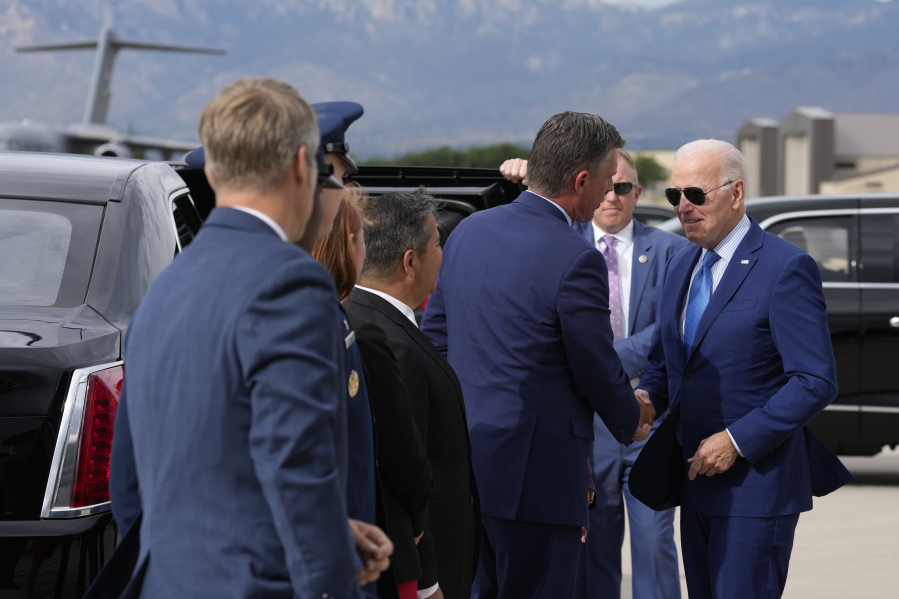ALBUQUERQUE, N.M. (AP) — Bringing back factory jobs is one of the most popular of White House promises — no matter who happens to be the president.
Donald Trump said he’d do it with tariffs on imports. Barack Obama said companies would start “insourcing.” George W. Bush said tax cuts would do the trick. But factory jobs have struggled to fully return after each recession.
On Wednesday, President Joe Biden is making the case in a New Mexico speech that his policies of financial and tax incentives have revived U.S. manufacturing. His claim is supported by a rise in construction spending on new factories. But factory hiring has begun to slow in recent months, a sign that the promised boom has yet to fully materialize.
That hasn’t stopped the White House from telling voters ahead of the 2024 election that the Democratic president’s agenda has triggered a revival in factory work.
“Hundreds of actions coordinated through his entire government are sparking a manufacturing renaissance across the United States,” White House climate adviser Ali Zaidi told reporters ahead of Biden’s New Mexico speech, asking them to picture in their minds a crowded jobs fair in Belen, New Mexico, for the 250 workers that Arcosa plans to hire at a factory that makes wind towers.
The president is speaking as construction starts on Arcosa’s plant, which formerly made Solo cups and later plastics. The White House said that Arcosa had to lay off workers in Illinois and Iowa before his Inflation Reduction Act became law last year, but customers placed $1.1 billion in wind tower orders with the company afterward. The stock has risen more than 20% in the past 12 months.
Biden’s message on jobs is one he’s been repeating frequently.
At a Philadelphia shipyard last month, Biden offered his policies to fight climate change by shifting away from fossil fuels as a way to create jobs. He wants voters to think of his social and environmental programs as good for economic growth.
“A lot of my friends in organized labor know: When I think climate, I think jobs,” Biden said. “I think union jobs. Not a joke.”
Biden’s trip to the Southwest is shaded by his reelection campaign and the challenge posed by a majority of U.S. adults saying they believe the economy is in poor shape. The president is trying to break through a deep pessimism that intensified last year as inflation spiked. His trip included a Tuesday speech in Arizona and will end with remarks Thursday in Utah. In 2020, Biden won both Arizona and New Mexico, key states that he likely needs next year to secure another term.
The president does have a case to make to the public on employment. As the U.S. economy has healed from the coronavirus pandemic, hiring has surged at factories. Manufacturing jobs have climbed to their highest totals in nearly 15 years. This is the first time since the 1970s that manufacturing employment has fully recovered from a recession, expanding by 789,000 jobs since Biden took office.
But the pace of job growth at manufacturers has slowed over the past year. Factories were adding roughly 500,000 workers annually last summer, a figure that in the government’s most recent jobs report fell to 125,000 gains over the past 12 months.
Biden administration officials have said there are more factory jobs coming because of its infrastructure spending, investments in computer chip plants and the various incentives in the Inflation Reduction Act.
Their argument is that the incentives encouraged the private sector to invest, leading to $500 billion worth of commitments to make computer chips, electric vehicles, advanced batteries, clean energy technology and medical goods. They say that more factories are coming because, after adjusting for inflation, spending on factory construction has climbed almost 100% since the end of 2021.
In April, the Economic Innovation Group, a public policy organization, issued a report that called construction spending for factories a “nationwide boom.” The report notes there are signs that manufacturing gains are most prominent outside the Midwest, which has historically identified with the sector, as more plants open in southern and western states. But EIG is less sure that a full-fledged restoration of manufacturing is in the works as the sector has been in decline for decades.
Labor Department figures show that total factory employment peaked in 1979 at nearly 19.6 million jobs. With just under 13 million manufacturing jobs now, the U.S. is unlikely to return to that level because of automation and trade.
Adam Ozimek, chief economist at EIG, said jobs can be a flawed way to measure a manufacturing revival. He said better metrics include an increase in factory output, whether the U.S. can shift to renewable energy to blunt climate change and whether the government can achieve its national security goals of having a stronger supply chain.
“It’s way too early to declare anything like a manufacturing renaissance,” Ozimek said. “We are decades into structurally declining manufacturing employment. And it’s not at all clear yet whether the positive trends are going to outweigh that continuing headwind.”
The Inflation Reduction Act has been the centerpiece of Biden’s climate agenda. However, he’s been under pressure from some activists and progressives to declare a national climate emergency, something he was asked about in an interview with the Weather Channel while visiting the Grand Canyon in Arizona on Tuesday .
Biden said he’s already done that “practically speaking,” citing the legislative steps and executive action that he’s taken.
“It is the existential threat to humanity,” he said.



